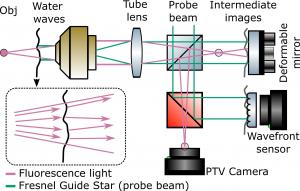Adaptive-Optical 3D Microscopy For Microfluidic Multiphase Flows
GA, UNITED STATES, September 9, 2024 /EINPresswire.com/ -- A real-time adaptive optics system was developed, characterised and applied to measure the 3D flow field through an oscillating surface of a water drop on an opaque Gas Diffusion Layer. A case study shows that the system corrects successfully measurement errors of the flow field that are caused by the refraction of light at the time-varying water-air interface.
Imaging and measurements based on optical microscopy can be severely impaired if the access exhibits variations of the refractive index. In the case of flow measurements through fluctuating liquid-gas boundaries, refraction introduces dynamical aberrations that increase the measurement uncertainty. This is prevalent at multiphase flows (e. g. droplets, film flows) that occur in many technical applications as for example in coating or cleaning processes and the water management in fuel cells. In this paper (doi: https://doi.org/10.37188/lam.2024.037), we present a novel approach based on adaptive optics for correcting the dynamical aberrations in real time and thus reducing the measurement uncertainty. The shape of the fluctuating water-air interface is sampled with a reflecting light beam (Fresnel Guide Star) and a Hartmann-Shack wavefront sensor which makes it possible to correct its influence with a deformable mirror in closed-loop operation. Three-dimensional flow measurements are achieved by using a double-helix point spread function. We measure the flow inside a sessile, oscillating 50-µl droplet on an opaque gas diffusion layer for fuel cells and show that the temporally varying refraction at the droplet surface causes a systematic underestimation of the flow field magnitude corresponding to the first droplet eigenmode which plays a major role in their detachment mechanism. We demonstrate that the adaptive optics correction is able to reduce this systematic error. The adaptive optics system can pave the way to a deeper understanding of water droplet formation and detachment which can help to improve the efficiency of fuels cells.
DOI
10.37188/lam.2024.037
Original Source URL
https://doi.org/10.37188/lam.2024.037
Funding information
The research project IGF-Nr. 21190 BG/2 from the research association DECHEMA e. V. is supported by the Federal Ministry of Economic Affairs and Energy through the German Federation of Industrial Research Associations (AiF) as part of the programme for promoting industrial cooperative research (IGF) on the basis of a decision by the German Bundestag.
Furthermore, this work is partially supported by the Deutsche Forschungsgemeinschaft (DFG, German Research Foundation) – project number 459505672.
Lucy Wang
BioDesign Research
email us here
Legal Disclaimer:
EIN Presswire provides this news content "as is" without warranty of any kind. We do not accept any responsibility or liability for the accuracy, content, images, videos, licenses, completeness, legality, or reliability of the information contained in this article. If you have any complaints or copyright issues related to this article, kindly contact the author above.


